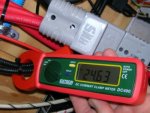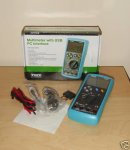Mad Professor
Senior Member
Good Day All.
I would like your thoughts and suggestions before I start my next project.
I will try and explain the basics of what I want to do.
My old man is very into green engey find solar and wind.
He now wants to be able to monitor in close to real time the voltage and current each solar panel and wind gen is making.
I have to get the real time data from the slave device(s) connected to the output of the solar panel or wind gen, to a PC to show live data and log the data.
I have two ways of doing this, (1) via wires or (2) via wireless connection.
I would like to go down the wireless route, but this is something I have no worked with yet.
The monitoring units will have to read 0-24vdc and up to 10amps.
To start with I am only looking at making one slave (monitoring unit), and what ever else is going to be needed to get the data into a PC.
But if all go’s well I would be looking at expanding up to 8 slave units.
So I know I am going to need a PicAxe with at least two ADC ports, and as I am going to be using the ADC ports I am going to need a super stable voltage to the PicAxe chip.
So I would now like you thoughts and suggestions.
Thanks for your time.
Best Regards.
I would like your thoughts and suggestions before I start my next project.
I will try and explain the basics of what I want to do.
My old man is very into green engey find solar and wind.
He now wants to be able to monitor in close to real time the voltage and current each solar panel and wind gen is making.
I have to get the real time data from the slave device(s) connected to the output of the solar panel or wind gen, to a PC to show live data and log the data.
I have two ways of doing this, (1) via wires or (2) via wireless connection.
I would like to go down the wireless route, but this is something I have no worked with yet.
The monitoring units will have to read 0-24vdc and up to 10amps.
To start with I am only looking at making one slave (monitoring unit), and what ever else is going to be needed to get the data into a PC.
But if all go’s well I would be looking at expanding up to 8 slave units.
So I know I am going to need a PicAxe with at least two ADC ports, and as I am going to be using the ADC ports I am going to need a super stable voltage to the PicAxe chip.
So I would now like you thoughts and suggestions.
Thanks for your time.
Best Regards.
Last edited:


